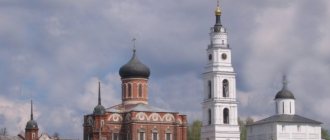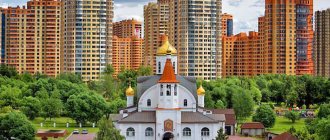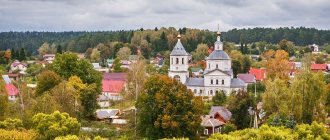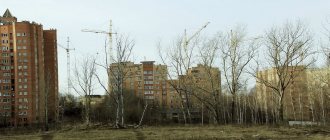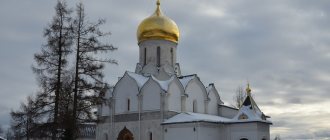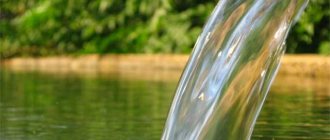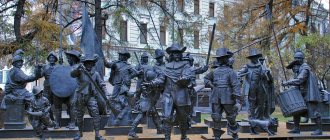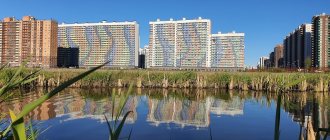A large settlement in the suburbs of Moscow with a population of almost 113 thousand people is located just 30 km southeast of the capital.
For the first time, Prince Ivan Kalita remembered it in one of his charters, but the founding date is considered to be 1760. By this time, on the coast of Lake Borisoglebsk, there was already a stone temple erected by Count P.I. Musin-Pushkin - Trinity. The village of Novo-Troitskoye, later Ramenskoye, appeared when the new owner of the surrounding lands, General M.N. Volkonsky, transported peasants here, built a house on the shore of the lake, around which he laid out a large park. Ramenskoye experienced particular prosperity with the advent of a textile factory, which in the 19th century became one of the largest in Russia in its industry.
Today, leading instrument-making enterprises in Russia operate in Ramenskoye, and the Avionics concern is included in the list of strategic production facilities of the Russian Federation. Sports occupy a special place in the life of the city. Ramensky's professional football and badminton teams have repeatedly become winners of national championships and prestigious cups, and the city pool serves as a training base for many water sports, including Olympic teams. Ramenskoye and its attractions usually await travelers as part of a one-day program.
What to visit in the city?
Where to go in Ramenskoye and what to see in the city in a few hours?
Colored houses
At the beginning of this century, an unusual project was implemented in the city, which has no common analogues in Russia. Giant positive paintings decorate high-rise buildings in one of the Ramenskoye microdistricts. The sea, palm trees, bright abstractions on the facades of houses look sunny and rainbow.
Temples
Among the ancient religious buildings of the city, it is interesting to see the Boris and Gleb Church and the Trinity Cathedral, built in the first half and middle of the 18th century.
Cartoon sculptures
An extraordinary highlight of the city are the sculptural compositions based on Soviet cartoons that were beloved in childhood, which are interesting to explore with children. Right on the street, old woman Shapoklyak is walking with her beloved rat Lariska, nearby is the crocodile Gena and Cheburashka, and Three from Prostokvashino have gathered nearby. These wonderful figures were created by local architect and sculptor Oleg Ershov.
LiveInternetLiveInternet
Saturday, October 02, 2010 08:21 + to the Syamuka
all posts by the author We have been going to Ramenskoye for a long time. That's what happened last weekend. After more than a month's vacation period, which completely excluded from our memory such a Moscow phenomenon as traffic jams, we leisurely left the house late Saturday morning, estimating that, taking into account the metro, in about two hours, at most - two and a half, we'll be there. Ramenskoye is located within 40 kilometers from the Moscow ring road. But, alas. We drove for a long, very long time - one continuous traffic jam on the Novoryazanskoe highway. So, instead of the expected 13.00 hours, we arrived in Ramenskoye at 15.00. But the low mood from the “turtle” ride was instantly compensated by what we saw - we were struck by the cleanliness and improvement of the city. From the bus window we noticed renovated houses, wooden and bronze sculptures from fairy tales and cartoons, fountains, benches and many flowers on the streets. True, unfortunately, until the evening we only managed to see the city center, but what we saw was impressive. It seemed that we were not in Russia at all, and not even in Europe. Although I remember seeing one painted house in Vienna. So local guides brought all the tourists to see this house. 8 On the streets of the city.
In short, we liked the city of Ramenskoye: the sidewalks were tiled, the houses were renovated and painted with paintings, and if not paintings, then they were painted with bright rainbow colors. Landscaped courtyards - with flower beds, with benches and trash cans, with paths and lanterns - in the courtyards there are simply fabulous playgrounds. There are many places to relax in the city - squares, boulevards, benches near fountains. In the center we counted 4 working fountains. Fairy-tale characters “walk” around the city. Here you can meet the inhabitants of Prostokvashino, Winnie the Pooh and his company, and the Wolf and the hare from “Well, wait a minute!” and sister Alyonushka and brother Ivanushka from a Russian folk tale... And besides ordinary lawns and flower beds, in Ramenskoye many three-dimensional figures were made from flowers: an elephant, a squirrel, a horse and a cart. And what’s interesting is that children are not prohibited from climbing on both the sculptures and flower figures. Little kids, and even adults, can “ride” any figure they like and do it with great pleasure. So Ramensky’s children have a place to walk and have fun, and the girls and boys who come to the city with their dad and mom for the weekend won’t be bored either, that’s for sure. In addition to sculptures and flower figures, together with your children you can see modern military equipment that is on display in the park. You can also touch it, and you can even “steer”. There is also Borisoglebskoye Lake in Ramenskoye. True, the current hot summer has deprived it of much water. The lake became very shallow, but the beautiful views remained. Initially, “Ramenye” (translated from the Old Russian language - border, edge of the forest) was mentioned in the spiritual letter of Ivan Kalita in 1328. Ramenye occupied a significant territory on which there were numerous settlements, including Novo-Troitskoye. In 1710, Peter I handed over the Ramenye area to Count Ivan Alekseevich Musin-Pushkin. Then the lands of Ramenya were owned by the Bestuzhev princes - the Ryumins, the Volkonskys, the Golitsyns. The city of Ramenskoye, judging by the standards of the birth of Moscow, is very young. It grew up around a textile factory that was founded in the village. Novo-Troitsk (later became the village of Ramensky) in 1831 by the princes Golitsyn, and which then passed to the merchants Malyutin. The village of Ramenskoye received city status in 1926. The historical core of the city formed along the shores of Lake Borisoglebsk. From antiquity, two churches have been preserved in Ramenskoye: Trinity and Boriso-Glebskaya. The construction of the Trinity Church was carried out at the factory at the expense of the merchant P. S. Malyutin and was completed in 1852. The church was originally five-domed in the Russian-Byzantine style. Later, a tented bell tower with porches and chapels was added to the church. In 1938, the church was closed, weddings were closed, and the premises served as a food processing plant. The church was reopened for parishioners in 1989, but during the restoration, one large dome was installed instead of the previous five-domed structure. The older one is the Boriso-Gleb Church (1725 - 1730). With a refectory and a bell tower, it was built at the expense of Count I. A. Musin-Pushkin. The new bell tower was built in the beginning. XIX century, and the decor was redone in the 1870s. The church was also closed in 1929. It houses a historical and art museum. The exhibits of the museum were noble property confiscated by the new government. In 2005, the Boriso-Gleb Church was returned to believers. It is currently undergoing restoration and renovation. Another attraction of the city of Ramenskoye, going back into history, is the city park of culture and recreation. The park was founded in the mid-18th century by Prince Pavel Mikhailovich Volkonsky. Prince Volkonsky organized an extraordinary garden, as the park was then called, with exotic tree species and a menagerie, and built an estate on the shore of Lake Borisoglebsky. The estate has not been preserved, but the park remains. Old trees grow here. Of course, it is difficult to immediately landscape and improve a large area of the park, but the park has paths, attractions, playgrounds and a Ferris wheel. We liked it both on Victory Square - the central square of the city, where the memorial and the Eternal Flame are located in honor of the fellow countrymen who died during the Great Patriotic War, and on Youth Square, where a beautiful fountain with figures plays with streams of water - the largest fountain in the city, and on Mikhalevich Street, where late flowers were planted with love and still delight with bright colors. ...We left Ramenskoye in the evening, when the slanting orange rays of the sun were already hugging the city and thick shadows lay on the asphalt. We left with a good mood and feeling. After all, you can, if you want... Mikhalevich Street is all in flowers.
Playground.
Flashlight.
Boulevard on the street Mikhalevich.
On the street Mikhalevich.
This is what panel houses look like.
…
…
…
Cat Matroskin.
Ball.
Conversation at the fountain.
" And I play…"
Clock on the city square.
Benches.
The sidewalks are paved with tiles.
…
Guryev street.
Flower elephant.
…
You can relax at any time.
Flower squirrel.
“Well, hare, wait a minute!”
…
Fragment of the fountain on the square. Youth.
…
…
House.
…
This is how pipes are decorated. Flower horse.
Riding Piglet.
Fountain "Creation of the World".
... Autumn in the city.
Boriso-Gleb Lake.
Eternal flame on the square Victory.
The registry office is located in this house.
Trinity Cathedral.
…
Boris and Gleb Church.
In the park. Modern military equipment.
Cited 6 times Liked by: 6 users
Like share
0
Like
- 6
I liked the post - Quoted
- 0
Saved
- Add to quote book
- 0
Save to links
Liked6
0
Estates in the surrounding area
Ramensky district deserves a separate weekend excursion tour. Ancient estates are undoubtedly worthy of the attention of tourists. Photos and descriptions of attractions can be found in guidebooks for the Moscow region.
Bykovo Estate
The Bykovo estate in the village of the same name looks like a miniature English palace surrounded by a park in which about 60 tree species have been preserved to this day. The Bazhenov rotunda and the church in the pseudo-Gothic style were once beautiful. The estate buildings were erected by the best architects of the second half of the 17th century at the invitation of the owner - the Governor-General of the capital M.M. Izmailov.
Nikitskoye Estate
The Nikitskoye estate in the village of the same name was built for General Apraksin, then belonged to the emperor’s relative Alexander Fedorovich. Near the house, the Vladimir Church was built at the beginning of the 18th century, which has been preserved and now services are held in it.
Denezhnikovo Estate
The Denezhnikovo estate, located near the Bronnitsa station, remains in a completely deplorable state. The once amazing architectural ensemble, built in the classicist style, surrounded by a shady park and a pond, is now virtually destroyed. All that remains are the outbuildings, which were put in order by the administration of a nearby factory for a children's camp, and the tower and park require the intervention of garden designers.
Estate Stepanovskoe
The Stepanovskoye estate and the Annunciation Church with it belonged to the founder of the Romanov royal dynasty N.R. Zakharyin-Yuryev, who received it in gratitude for his devoted service to the tsar and the capture of Kazan.
Restoration work is currently underway in the church and nearby outbuildings. The attractions of the Ramensky district are remarkable for their diversity and educational interest.
Ramenskoye
One day, in the summer of 2006, my wife and I found ourselves at the Kazansky railway station, seeing off a relative. And we decided, just like that, to take a ride to Ramenskoye.
We liked the city so much that we decided to settle here. And we lived in Ramenskoye for almost 5 years.
The Ramenskoye volost was first mentioned in written sources in 1328. The village gradually developed and changed names. In 1831, a weaving factory opened here. After 30 years, the factory became one of the largest in Russia. The factory operated until 2007.
With the flourishing of the factory in 1862, a railway station appeared in Ramenskoye, where intercity trains stopped. For example, the Kazan-Moscow train, which traveled from Ramenskoye to Kazansky station in 98 minutes. Now regular trains go to Kazan in 68 minutes, and high-speed trains in 45. The station itself was destroyed in 2004 and now a shopping center has been erected in its place class=»aligncenter» width=»900″ height=»600″[/img]
In the center of the city is Lake Borisoglebsk. After the peat bogs were drained during Soviet times, the water level dropped significantly, and the surrounding areas began to suffer from peat fires in the summer. Before the revolution, Prince Volkonsky owned the lake, a park was laid out near the lake, and a pleasure boat sailed on the lake.
Every year at the beginning of the new year, fans of railway modeling from all over Russia gather at the Ramenskoye Museum of Local Lore. For this reason, it’s worth coming to Ramenskoye in winter to go to the museum.
The city is located between the Novoryazanskoye and Yegoryevskoye highways, but the fastest way to get to it is by Sputnik electric trains, which run from the Kazansky station (45 minutes on the way) and stop at the Vykhino metro station (30 minutes on the way).
At the beginning of this century, the mayor of the city decided that gray panel high-rise buildings and Khrushchev buildings looked terrible and a city improvement project began in the city. And he accomplished a lot. Therefore, it’s worth coming to Ramenskoye in the summer to walk around the city.
The coloring of the houses began like this:
Result:
When the turn came to the Khrushchev buildings, we decided to use calmer colors.
A city sculpture appeared. Children began to enjoy cartoon characters, and men began to enjoy the erotic lady with a dog.
Flower sculptures began to be planted on Guryev Street, and in winter they were dressed in outfits made of pine branches.
Fountains have appeared in the city, which are always crowded in the summer.
How can the soul not sing from such beauty?
You can also visit Ramenskoye on days when the International Aerospace Salon is taking place in neighboring Zhukovsky. Residents of the city, a few days before this event, begin to hear the roar of heavy aircraft taking off from the Ramenskoye airfield.
And in gratitude for this, the pilots give the ramenites a heart.
Not so long ago, this small town had its own football team, Saturn, defending the honor of the city and the Moscow region in the Premier League. The games took place in a modern stadium surrounded by huge pine trees.
The star of the club was goalkeeper Antonin Kinski, one of the best goalkeepers in our Premier League. The fans, of course, wanted more.
And then the “aliens” showed their class.
Unfortunately, for a number of reasons, the old “Saturn” no longer exists, the team owed huge sums to players, coaches, and staff, went bankrupt and was relegated from the Major League. Now Saturn lives somewhere on the outskirts of the third league. And Anzhi trains at an excellent base in Kratovo.
Let's take a walk around the city. Lake Borisoglebsk looked like this in 2006.
In 2011, the Borisoglebsky sports complex and a residential neighborhood were built on the opposite side.
And this is what the panorama of Borisoglebsky Lake looked like in 2013.
Weaving factory at night. The factory buildings, although they are monuments of industrial architecture, are gradually falling into disrepair. I hope that the developers of the shopping complex on the site of the factory will reconstruct and preserve the buildings.
The Church of Saints Boris and Gleb on the lake stood here back in 1628. Now the Cathedral of the Life-Giving Trinity stands here, and the Boris and Gleb Church is behind it. The cathedral in pseudo-Russian style was built at the expense of the factory manager, merchant Malyutin. During Soviet times, there was a food shop inside; now the church has been returned to the Russian Orthodox Church.
Immediately adjacent to Ramenskoye is the former possession of the Volkonsky princes - the village of Dergaevo. There once stood a beautiful school here, in the Victorian style. A new school was built nearby and, by a mysterious coincidence, the old school caught fire and was demolished overnight.
Ramenskoye at sunset. The small building with a red roof in the foreground is the entrance of the Ramensky Instrument-Making Design Bureau. This design bureau maintains a leading position in the field of avionics to this day. In particular, electronics for a fifth-generation fighter are being designed here.
Night Ramenskoye. The lights in the distance are Novoryazanskoye Highway.
Ramenskoye is a very cozy city and we always remember it with warmth.
There is a private sector here, and in the spring, areas with private buildings are fragrant with blooming apple, cherry and bird cherry trees.
A few more details:
One of the best places in the city where you can drink coffee and cake is the Lakomka cafe on Sovetskaya Street not far from Vokzalnaya Square.
As souvenirs in Ramenskoye you can buy the most delicious and environmentally friendly mayonnaise “Lyubitelsky” from the local one. These manufacturers continue to maintain quality products over the years.
Ramenskoye-2013
2 years later, in March 2013, we returned to Ramenskoye again to look at the changes that had taken place in the city.
Horse-drawn vehicles were prohibited from passing along Guryev Street. After all, it’s the 21st century.
A certain pillar appeared in the park, apparently a border post. It is not clear to us why the Russian border passes through Ramenskoye Park. In addition, together with the wreath, the pillar looks more like a grave.
An exhibition of military equipment in the park appeared back in 2010, but we only photographed it now. There has been more technology over time.
Active development continues along Dergaevskaya Street. I am glad that architects continue to use façade color schemes that are bold for our latitudes. The tradition of “painted houses” continues.
Postman Pechkin with a bicycle was placed at the monument to Cat Matroskin and Sharik. If things go like this, then in a couple of years Uncle Fyodor will appear here, and by 2021 his mom and dad will arrive.
Useful tips
[osm_map lat="55.66" long="37.954" zoom="10" width="600" height="450" marker="55.577,38.236" marker_name="wpttemp-yellow.png" control="scaleline,mouseposition" theme=”dark” type=”Mapnik”]
- Why go? Look at painted houses and sculptures of cartoon characters. An exhibition of railway modeling in the city's local history museum.
- When to go? The city is beautiful at any time of the year.
- What to do in Ramenskoye in winter? Ski! Read our review of the Ramenskaya ski track.
- How to get there? 35 kilometers from the Moscow Ring Road along Novoryazanskoye Highway.
- How long to spend? All day.
- What to do with a child? Children will definitely enjoy a walk through the park and viewing cartoon sculptures.
- Where to eat? At the Lakomka cafe.
- What to bring home? Locally produced mayonnaise and sausage. Environmentally friendly and tasty product!
Similar
Famous Gzhel
One of the most exciting excursions in the vicinity of Ramenskoye is a trip to the Gzhel factory, the oldest and largest Russian company producing porcelain tableware, unique in its beauty and unsurpassed in quality. In the production museum, tourists are introduced to the history of ceramics, master classes are held for children and adults on sculpting and painting, which have survived to this day from the 14th century, and they will also show unique exhibits created back in the 15th century, and the world’s largest model of a vase.
Travel and accommodation
How to get to Ramenskoye from the capital? Simply - by train Moscow-Ramenskoye or minibus, which depart from the capital every 15-20 minutes. If one day is not enough to explore the city, Ramenskoye hotels will kindly open their doors to travelers. It should be noted that any hotel in Ramenskoye is no worse than the capital - comfort and service are at a high level, and prices are much lower than the cost of living in Moscow tourist complexes.

